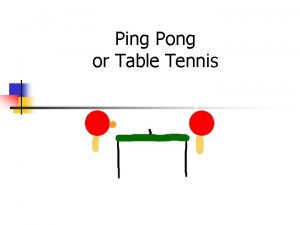Distance per Stroke DPS Counting strokes measuring stroke








- Slides: 8

Distance per Stroke (DPS) • Counting strokes, measuring stroke rates, and relating those to a swimming pace help swimmers focus on efficiency. • The fewer strokes you take and the faster you go, the more efficient you become. • The reason that DPS is done as a drill is to practice making the pulling phase more efficient as well as determining the correct timing of the stroke; therefore making the swimmer faster. • Distance per stroke is where you want to maximize the distance that you get from your stroke while holding the maximum speed with the pull. In other words, each pull will propel you through the water. • The swimmer will hit a peak speed during the pull. At the point of the peak your other arm should be poised and ready to pull to maintain that speed.

Distance per Stroke (DPS) Some variable are measurable such as stroke rate (SR) and distance per stroke cycle (DPS). SR and DPS are important because both factors directly influence how fast you swim: Swimming speed = DPS x SR Consider the implications of this relationship. You will improve your speed if you can do the following: 1. Increase your stroke rate while maintaining the distance you travel with each stroke. 2. Increase the distance traveled with each stroke while maintaining your stroke rate. 3. If you can increase both simultaneously, you will swim faster still.

Distance per Stroke (DPS) Stroke rate is a measure of how fast the arms “turn over” and is typically expressed in cycles per minute. For example, a freestyle swimmer with a stroke rate of 58. 5 stroke cycles per minute would take that many stroke cycles every minute she swims. Keep in mind that both arms pull together in butterfly and breaststroke, so the start of one pull to the start of the next pull represents one stroke cycle. In freestyle and backstroke, both arms pull independently, and a stroke cycle is measured from the start of one arm pull to the start of the next arm pull made by the same arm (for example, the time from right-hand entry to the next right-hand entry). While there are many reference points you could choose to define the start and stop of a stroke cycle, the important thing is to choose one to maintain consistency in your measurements. Stroke rate is something you can have a friend, coach, or training partner measure. There are many stopwatches now that have a stroke rate function and will compute your stroke rate for you. But even if you do not have a stopwatch that computes stroke rate, you can figure this out on your own with a normal stopwatch and by doing some simple math. Have a teammate or your coach time how long it takes you to complete three stroke cycles. Start the watch at the beginning of a stroke cycle (for example, right-hand entry in freestyle) Stop the watch at the start of the fourth stroke cycle. This represents three full cycles. Compute your stroke rate using the following equation: SR = 3/(Time, in seconds, to complete 3 stroke cycles) x 60 This equation will give you a measure of the number of stroke cycles you take per minute.

Distance per Stroke (DPS) Distance per stroke (DPS) is a measure of how far you travel with each stroke cycle you take and is typically expressed in meters traveled per cycle. Distance per stroke is directly related to how effectively you pull. Counting strokes is pretty straightforward, but how do you compute the distance you travel with each stroke? The key is to rearrange the equation to find the following: DPS = Swimming speed/SR To compute distance per stroke, you will need to know your split (to get your swimming speed) as well as your stroke rate. 1. Have your coach record your splits every 50 meters during your race or get the official splits from the meet results. 2. Compute your stroke rate using the previous equation. 3. Have a team-mate time how long it takes you to complete three stroke cycles once every 50 meters and compute your stroke rate. It is typically best if you compute stroke rate during the second half of the 50. 4. Plug the splits and stroke rate data into the following equation: DPS = [50/ (50 -meter split time, in seconds) x SR] x 60 5. The result of this calculation tells you how many meters you travel with each stroke cycle. There will be some small errors in the DPS measurement since a part of your 50 -meter split time is not actual swimming time—some time is spent underwater pushing off the wall or setting up for the turn. These computations will likely overestimate your DPS slightly. However, if you use this method consistently, you will be able to compare swims and see how distance per stroke improves over the course of a season.

Distance per Stroke (DPS) The purpose of DPS is for you to apply the drills you have learned to their stroke as a whole, so that they are more efficient. You should work on increasing the distance covered per stroke to increase feel for the water, strength, and stroke efficiency. • This is measured easily by counting the number of strokes you take per length. • Your goal, over time as your stroke improves, should be to lower this count. • It is important that you perform DPS at a moderate effort to rate mimic a stroke as you would in a race (don’t glide and kick as much as possible in order to get a low count). • Two common ways of doing DPS are described below: – �DPS Drill: • Do sets of 50 meters/yards and try to reduce your number of strokes per 50 each time. • Swim as you would for the first 50. • As you progress, try to keep the same effort but put more emphasis on an extended reach and full pull through on the back portion of your stroke. • A gliding action should occur as you push through the back portion of your stroke and your hand is extended out front. – �A way to test progress is known as the Golf Drill: • This drill is used to increase efficiency as well as turnover. • You will perform a 50 meter/yard swim and in doing so will (1) get you time and (2) count the number of strokes it took. • Add those two numbers together to create a score. • The lower the score the better the performance. • As you improve you will reduce your score by: – (1) taking less strokes/increasing their DPS while maintaining the same number of strokes – (2) maintaining their number of strokes and decreasing their overall time – (3) decreasing the number of strokes they take/increasing their DPS and decreasing the amount of time

Distance per Stroke (DPS) What is distance per stroke (DPS) for a swimmer? Think of it as getting more distance for each swimming cycle through increased efficiency, not by reaching further in front or pushing further in back. Here are some of the steps to swim through that should help you improve your distance per stroke: – Get in a good body position, long and straight, with the top of your head pointing the way you are going. – Slow down the pull. – Feel your hand enter. – Extend to a natural stopping point with no over-reach. Your body should rotate around your spine, with the shoulder/hip on the same side of the arm extending rotating towards the bottom of the pool while the opposite side rotates towards the sky - you will be more on edge (maybe mentally, too) than flat. – Leave your extended arm's elbow relatively high (close to the surface of the water). – Bending at the elbow (and possibly wrist a bit), point your fingers, hand, wrist, forearm structure (fhwf) towards the bottom of the pool (this is the catch). – Keeping your fingers, hand, wrist, forearm structure (fhwf)pointing towards the bottom of the pool, press on the water (backwards).

Distance per Stroke (DPS) – BIG POINT HERE - NO S CURVE - NO MOVING OF THE FHWF STRUCTURE AWAY FROM POINTING AT THE BOTTOM OF THE POOL - THE ELBOW/FOREARM/SHOULDER ANGLE WILL CHANGE, BUT ATTEMPT TO KEEP THE FHWF STRUCTURE ORIENTED STRAIGHT DOWN. – AT THE SAME TIME AS YOU FINISH THE CATCH AND BEGIN THE PRESS, BEGIN TO ROTATE TO THE OPPOSITE SIDE. – AT THE SAME TIME AS YOU BEGIN THE CATCH, THE OPPOSITE ARM SHOULD BE AT OR ALMOST AT #3. – As you press on the water and the fhwf structure passes your waist, your elbow will begin to surface and you will start to feel a loss of pressure on the fhwf structure. – When you feel a major loss of pressure, lift the elbow and get the whole arm up, into the air, for its recovery. AT THAT POINT THE OPPOSITE ARM SHOULD BE AT #4. – Swing the arm forward with a high elbow and relaxed FHWF structure until you reach #3. – You should breath away from the hand entering the water, when that hand is in the #34 range, so you have finished the breath BEFORE the hand on the breathing side gets to #3. – This needs to be felt and worked through at a slower pace, then practiced at a faster pace.

Distance per Stroke (DPS) – Initially you can lay on your side (WITH FLIPPERS ON, GENTLE KICKING!!) underwater side of your body's arm extended, other arm down, laying along your side, top of your head pointing the direction you are traveling. – Count to 10, eyes looking sideways with one eye directly above the other, mouth out of the water. – At 10, take one arm pull and recover with the other arm, rotate your body 180 degrees and mouth out again on the other side. – During this rotation, your head should never leave its point position, aiming towards your destination. – As that gets more comfortable, start decreasing the count between side switches. I call this drill head point with X-count switch. – Minimize any swaying motions and any over-extensions or over-reaching. This technique is all about: – A straight line body position. – Rotating around your spine. – A pointing straight to the bottom FHWF structure. – Overlap timing by getting one hand in the water before the other hand gets too far along in the press. – Note that there is variation in angles of FHWF structure from a head-on view. I like swimmers to work on the "straight to the bottom of the pool" point for now, to decrease the amount of cross-over that can occur during breathing. It may help you to think of it in two ways, one from the point of view of an eyeball stuck in your belly, and one from the point of view of an eye watching as you swim over the top of it. The belly-eye would see the FHWF start off far away, move in towards it, then move far away again, while the bottom-eye would see the FHWF structure point towards it and stay pointing towards it as the body swam over the top of it. – Increasing your ability to cover more distance per stroke is one more tool you can use to improve your overall swimming. This skill is useful for all levels of athletes in almost any distance race or workout set. Try some of these swimming technique tips next time you are in the pool and let me know how it goes.















